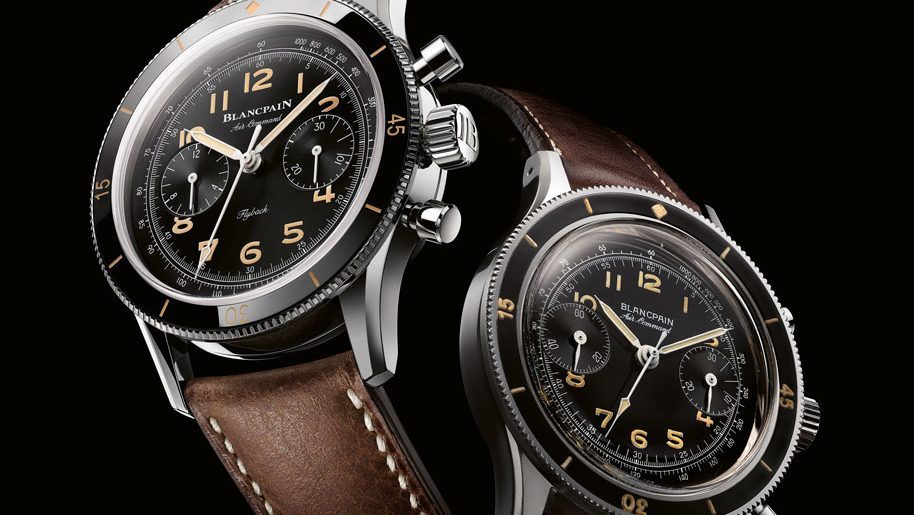
Blancpain has dug deep into its archives for its new limited-edition pilot’s watch, says Chris Hall.
Close followers of the Swiss watch industry will know that it enjoys a somewhat capricious relationship with its history. On the one hand, the centuries of watchmaking experience and tradition are what give modern-day brands their value and position at the top of the luxury tree. However, it has been known for those same brands to take a selective view of 20th-century developments, especially when they don’t align perfectly with the current marketing strategy.
In the 1990s and early 2000s this was less pronounced, because companies were concerned with surging forward, creating new designs and styles (not all of them successful). Since then, however, bound symbiotically to an enormous uplift in the vintage watch market, the brands’ strategies have crystallised around recreating models from their glorious past – primarily the 1960s and ’70s – throwing greater attention on to what was actually going on back then.
A cursory search for Blancpain will reveal the claim that it is the world’s oldest surviving watch brand, dating its inception to 1735. Few top-line summaries, and certainly not the official corporate history, will mention that it was one of the hardest-hit victims of what the Swiss refer to as the “quartz crisis”, when at the start of the 1970s battery-powered watches decimated the market.
Blancpain went completely out of business for close to a decade; in 1983, the name was purchased by marketeer Jean-Claude Biver and watchmaker Jacques Piguet for SFr 22,000 (£17,000). The pair restarted the business, marketing it with the bold claim that: “Since 1735 there has never been a quartz Blancpain watch. And there never will be.” They sold it in 1992 for SFr 60 million (£47 million). (Funnily enough, this comes up rather more frequently in profiles of Mr Biver.)
STORIED PAST
If you’re wondering how this is germane to the picture of the handsome chronograph above, we’re getting there. This is the Blancpain Air Command, a 500-piece limited edition high-end chronograph (£15,170) announced to the world in May as Blancpain’s hero piece for 2019. Its story is an interesting one, made all the more so for being shrouded in uncertainty. Blancpain in the 1950s was riding high; it had developed the Fifty Fathoms dive watch for the French Navy in 1953 (a year before Rolex’s Submariner) and supplied it to elite naval units across the world, including the US.
Soon after, the story goes, the Americans came calling again, looking for an aviation watch. It had to have a flyback chronograph function (the ability to stop timing, reset to zero and restart again in one integrated action; useful for synchronising timing across a team), and a black dial with legible, luminous markers and hands. Blancpain modified its Fifty Fathoms and supplied about a dozen prototypes to its US distributor, Tornek.
That’s about as much as anyone knows with any real certainty. The watch wasn’t commissioned by the US Air Force and, the consensus is, never went into production or saw the light of day commercially.
A couple of originals have surfaced at auction (fetching six-figure results in light of their rarity) but what’s lacking is any official documentation confirming their specifications or precise dates of production. Some vintage Air Commands have movements from Swiss manufacturer Valjoux and others are Blancpain-signed, implying some may have been retrofitted at a later date, but no one knows for sure which is period-correct.
If Blancpain really had enjoyed 284 years of unbroken history, chances are the backstory of the Air Command would be more complete. Records would not have been lost; the institutional memory of employees would have been retained. It would probably still be something of a curio, and I expect it would have been brought back to life all the same – perhaps earlier, perhaps not. One thing is for sure: the international community of hardcore collectors would have been deprived of a good argument over how many exist and their original specification, and as that’s one of the things that keeps me gainfully employed, perhaps I should be thankful things panned out this way.
Today’s watch is as faithful a replica as you can imagine; it’s half a millimetre bigger (42.5mm) and boasts clearer, larger numerals on the dial, but retains the overall layout, rotating bezel (unusual for a pilot’s watch) and lack of a date window. Inside is a high-frequency, top-grade chronograph movement, capable of timing to one-tenth of a second, and visible through the sapphire crystal on the underside of the watch. Here you’ll also see a somewhat kitsch propeller-shaped winding rotor (jet engines being ubiquitous by the early 1950s), overlooking a movement that is – as usual from Blancpain – superbly finished.












